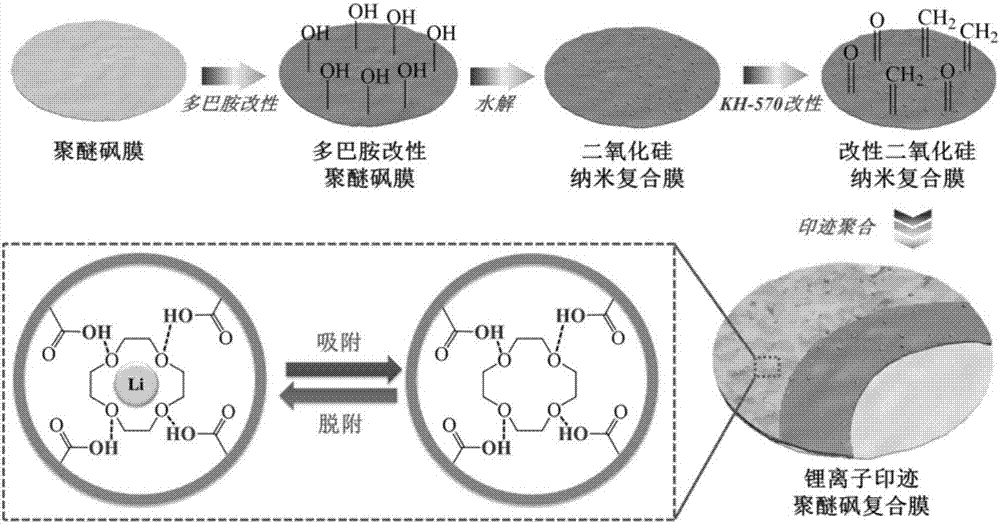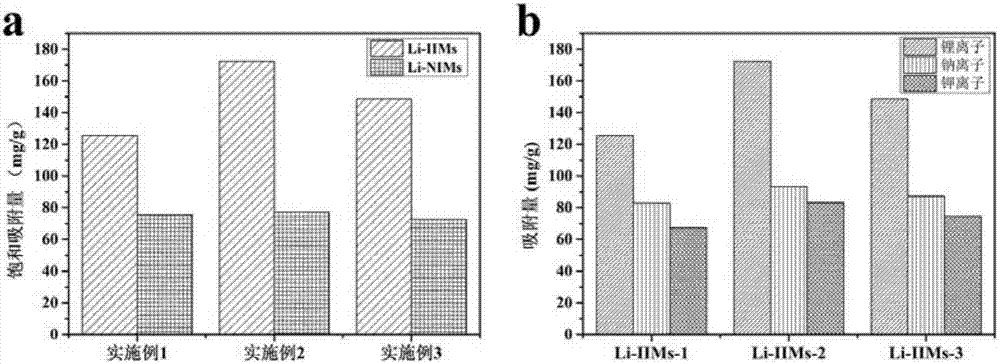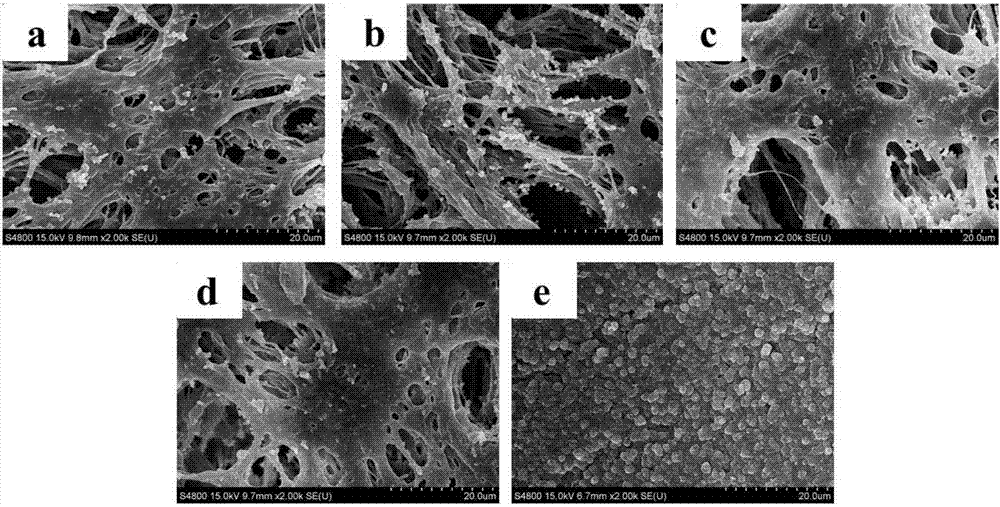Preparation method and application of lithium-ion-imprinted polyethersulfone composite membrane
A polyethersulfone membrane and lithium ion technology, which is applied in the field of preparation of lithium ion imprinted polyethersulfone composite membrane, can solve the problem of inability to achieve efficient separation of lithium ions, and achieve a remarkable separation effect, improved identification efficiency, and strong regeneration. Effect
- Summary
- Abstract
- Description
- Claims
- Application Information
AI Technical Summary
Problems solved by technology
Method used
Image
Examples
Embodiment 1
[0046] Step 1. Dopamine modification on the surface of polyethersulfone membrane
[0047] First, 0.1211g tris(hydroxymethyl)aminomethane hydrochloride (Tris) and 0.2g dopamine hydrochloride (DA) were placed in 100mL deionized water, mixed uniformly under ultrasonic conditions, and the pH value of the mixed solution was adjusted to 8.5, and 3 A piece of polyethersulfone membrane PSMs was immersed in the mixed solution, and reacted for 3 hours under shaking at room temperature. The membrane obtained after the reaction was taken out, soaked and washed with deionized water three times, each time for 10 minutes, and dried at room temperature. , dopamine-modified polyethersulfone membranes (dPSMs).
[0048] Step 2, preparation of silica nanocomposite film
[0049] First, 1 mL of tetraethyl silicate (TEOS) was added to a mixed solution of 35 mL of ethanol and water (ethanol: water = 30 mL: 5 mL), and mixed uniformly under ultrasonic conditions. After the polyethersulfone membrane d...
Embodiment 2
[0066] Step 1. Dopamine modification on the surface of polyethersulfone membrane
[0067] First, 0.1211g tris(hydroxymethyl)aminomethane hydrochloride (Tris) and 0.2g dopamine hydrochloride (DA) were placed in 100mL deionized water, mixed uniformly under ultrasonic conditions, and the pH value of the mixed solution was adjusted to 8.5, and 3 A piece of polyethersulfone membrane PSMs was immersed in the mixed solution, and reacted at room temperature for 6 hours. The membrane obtained after the reaction was taken out, soaked and washed with deionized water three times, each time for 10 minutes, and the washed membrane was dried at room temperature. , dopamine-modified polyethersulfone membranes (dPSMs).
[0068] Step 2, preparation of silica nanocomposite film
[0069] First, 1 mL of tetraethyl silicate (TEOS) was added to a mixed solution of 35 mL of ethanol and water (ethanol: water = 30 mL: 5 mL), and mixed uniformly under ultrasonic conditions. After the polyethersulfone ...
Embodiment 3
[0086] Step 1. Dopamine modification on the surface of polyethersulfone membrane
[0087] First, 0.1211g tris(hydroxymethyl)aminomethane hydrochloride (Tris) and 0.2g dopamine hydrochloride (DA) were placed in 100mL deionized water, mixed uniformly under ultrasonic conditions, and the pH value of the mixed solution was adjusted to 8.5, and 3 A piece of polyethersulfone membrane PSMs was immersed in the mixed solution, and reacted at room temperature for 9 hours. The membrane obtained after the reaction was taken out, soaked and washed with deionized water three times, each time for 10 minutes, and the washed membrane was dried at room temperature. , dopamine-modified polyethersulfone membranes (dPSMs).
[0088] Step 2, preparation of silica nanocomposite film
[0089] First, 1 mL of tetraethyl silicate (TEOS) was added to a mixed solution of 35 mL of ethanol and water (ethanol: water = 30 mL: 5 mL), and mixed uniformly under ultrasonic conditions. After the polyethersulfone ...
PUM
| Property | Measurement | Unit |
|---|---|---|
| Adsorption capacity | aaaaa | aaaaa |
| Adsorption capacity | aaaaa | aaaaa |
| Adsorption capacity | aaaaa | aaaaa |
Abstract
Description
Claims
Application Information
 Login to View More
Login to View More - R&D
- Intellectual Property
- Life Sciences
- Materials
- Tech Scout
- Unparalleled Data Quality
- Higher Quality Content
- 60% Fewer Hallucinations
Browse by: Latest US Patents, China's latest patents, Technical Efficacy Thesaurus, Application Domain, Technology Topic, Popular Technical Reports.
© 2025 PatSnap. All rights reserved.Legal|Privacy policy|Modern Slavery Act Transparency Statement|Sitemap|About US| Contact US: help@patsnap.com



